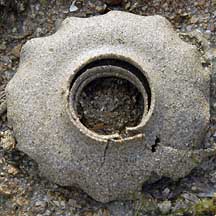| Scientific classification | |
|---|---|
| Kingdom: | Animalia |
| Phylum: | Mollusca |
| Class: | Gastropoda |
| (unranked): | clade Caenogastropoda clade Hypsogastropoda clade Littorinimorpha |
| Superfamily: | Naticoidea |
| Family: | Naticidae |
| Subfamily: | Polinicinae |
| Genus: | Polinices |
| Species: | P. mammatus |
| Binomial name | |
| Polinices mammatus | |
Moon snails belong to the Family Naticidae. These include the Genus Natica, which have a thicker operculum that is shell-like (usually white); and the Genus Polinices, which have a thin operculum made of a horn-like material (usually yellowish) with several whorls.
Where seen?
These fierce burrowing snails are commonly seen on our sandy shores. These snails are more commonly seen above ground at night. But a keen observer may still detect their presence by the distinctive trails these snails leave on the surface as they quietly burrow just beneath the sand.
Features:
5-6cm. Shell thick and oval, the spiral tip smoothly sticking out so the overall shape resembles a breast (mammilla means 'breast' in Latin). The shell is usually white, glossy and unmarked, but sometimes with large irregular patches of brown, black, orange or yellow. There is often large bump on the underside near the shell opening. The underside is usually completely white. The thin operculum is made of a horn-like material and is smooth and amber yellow. The body is plain white. It's very hard to get a good look at the entire body as the snail retracts quickly and completely into the shell when it is disturbed.
The body forms a wedge shape that helps the snail move under the sand. The front of the foot is used like a plough. A part of the foot covers the head as a protective shield. The tentacles and siphon stick out of this shield. The mantle (a part of its body) extends in two flaps over the shell on either side.
A moon snail's shell often remains shiny and lustrous because the mantle envelopes its shell, and the snail spends most of its time under the sand. Encrusting animals have little chance of establishing on the shell of a living Moon snail.
What do they eat?
Role in the habitat:
These fierce burrowing snails are commonly seen on our sandy shores. These snails are more commonly seen above ground at night. But a keen observer may still detect their presence by the distinctive trails these snails leave on the surface as they quietly burrow just beneath the sand.
Features:
5-6cm. Shell thick and oval, the spiral tip smoothly sticking out so the overall shape resembles a breast (mammilla means 'breast' in Latin). The shell is usually white, glossy and unmarked, but sometimes with large irregular patches of brown, black, orange or yellow. There is often large bump on the underside near the shell opening. The underside is usually completely white. The thin operculum is made of a horn-like material and is smooth and amber yellow. The body is plain white. It's very hard to get a good look at the entire body as the snail retracts quickly and completely into the shell when it is disturbed.
The body forms a wedge shape that helps the snail move under the sand. The front of the foot is used like a plough. A part of the foot covers the head as a protective shield. The tentacles and siphon stick out of this shield. The mantle (a part of its body) extends in two flaps over the shell on either side.
A moon snail's shell often remains shiny and lustrous because the mantle envelopes its shell, and the snail spends most of its time under the sand. Encrusting animals have little chance of establishing on the shell of a living Moon snail.
What do they eat?
Moon snails are fierce predators. They feed on bivalves and snails. A moon snail wraps its huge foot around the hapless prey to suffocate it. If this fails, it has a gland at the tip of its proboscis that secretes an acid to soften the victim's shell. With its radula, a hole is slowly drilled through the shell. The hole created by a moon snail is usually neat and bevelled.
Moon babies:
Moon babies:
The sand collar is the moon snail's egg mass. A moon snail lays her eggs at night. The eggs are laid singly in capsules which are embedded in a matrix of sand grains - a combination of mucus and sand which forms a gelatinous sheet that hardens. She lies at the center of the collar as she creates it, so the hole in centre of the collar gives an indication of the size of the mother snail. Although the collar feels hard, plasticky and appears dead, each collar can contain thousands of living eggs. When the eggs hatch, the collar disintegrates. Thus, an intact collar has living snails in it! Please don't damage the sand collars. Sand collars are sometimes numerous on the sand bar and seagrass lagoon.
 Sand collar (http://www.wildsingapore.com/wildfacts/mollusca/gastropoda/naticidae/sandcollar.htm)
Sand collar (http://www.wildsingapore.com/wildfacts/mollusca/gastropoda/naticidae/sandcollar.htm)
 Sand collar (http://www.wildsingapore.com/wildfacts/mollusca/gastropoda/naticidae/sandcollar.htm)
Sand collar (http://www.wildsingapore.com/wildfacts/mollusca/gastropoda/naticidae/sandcollar.htm)Role in the habitat:
When a moon snail dies, its shell is quickly taken over by a hermit crab. Many of the moon snail shells you see on the surface will probably be so occupied. Living moon snails are rarely seen above ground during the day.
Credit: http://www.wildsingapore.com/wildfacts/mollusca/gastropoda/naticidae/naticidae.htm
Credit: http://www.wildsingapore.com/wildfacts/mollusca/gastropoda/naticidae/naticidae.htm

No comments:
Post a Comment